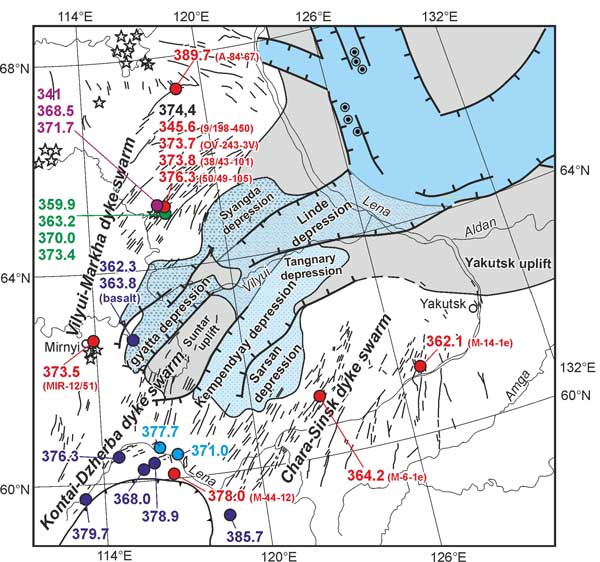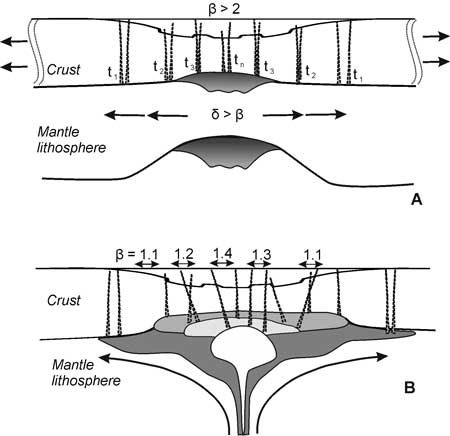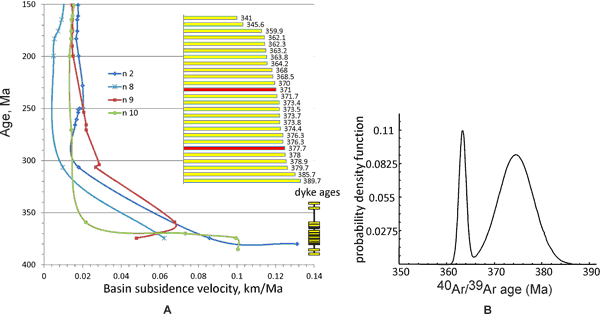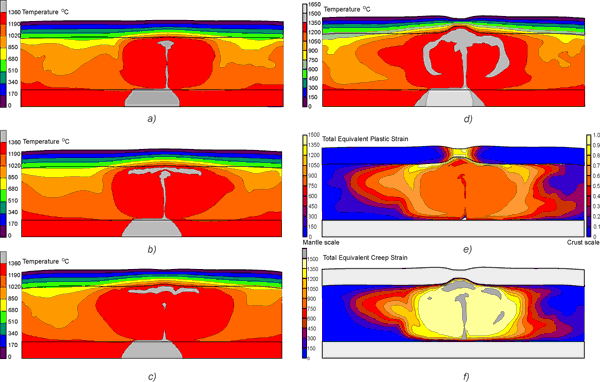 |
Time correlation between the formation of dyke swarms and crustal extension stages in the Middle Paleozoic Vilyui rift basin, Siberian platform |
Oleg P. Polyanskya*, Andrei V. Prokopievb, Olga V. Korolevab, Mikhail D. Tomshinb, Vladimir V. Reverdattoa, Alexander Yu. Selyatitskya, Alexei V. Travina, Dmitry A. Vasilievb
aSobolev Institute of Geology and Mineralogy, Siberian Branch, Russian Academy of Sciences, Ak. Koptyug Prospect 3, Novosibirsk 630090, Russia, pol@igm.nsc.ru ; travin@uiggm.nsc.ru ; rever@igm.nsc.ru ; selax@igm.nsc.ru
bDiamond and Precious Metal Geology Institute, Siberian Branch, Russian Academy of Sciences, Lenin Prospect 39, Yakutsk 677980, Russia, prokopiev@diamond.ysn.ru ; o.v.koroleva@diamond.ysn.ru ; tmd@diamond.ysn.ru ; juorankhay@mail.ru
This webpage is a summary of: Polyansky O.P., Prokopiev A.V., Koroleva O.V., Tomshin M.D., Reverdatto V.V., Selyatitsky A.Yu., Travin A.V., Vasiliev D.A. Temporal correlation between dyke swarms and crustal extension in the middle Palaeozoic Vilyui rift basin, Siberian platform, Lithos, 2017, dx.doi.org/10.1016/j.lithos.2017.02.020.
Dyking, subsidence and extension
Dyke swarms extending for hundreds of kilometers with a cumulative thickness of hundreds of meters to kilometers are a feature of continental rifting, and widely used in tectonic plate reconstructions. Many large igneous provinces (LIPs) are spatially associated with intracontinental sedimentary basins, particularly rift-related ones (Bryan & Ernst, 2008). The periods of basic magmatism coincide with synrift and postrift stages of basin development. In relation to the problem of the origin of the Vilyui basin (Polyansky et al., 2013; 2014) and the associated Yakutsk-Vilyui LIP (Ernst, 2014), it is vital to understand the time correlation between dyke intrusion and stages of extension and rapid subsidence in different parts of the basin. In this study we present nine new 40Ar/39Ar ages for plagioclase and pyroxene grains from dolerites and quartz monzonites in the dyke swarms framing the Vilyui rift basin. Seventeen previously published 40Ar/39Ar and U-Pb dates of dykes of these swarms were used in statistical analysis (Figure 1).
Backstripping has been used to analyze data from 14 boreholes within an area 400 x 250 km along the longitudinal and transverse axes of the Vilyui basin (Prokopiev et al., 2001). Two stages of rapid subsidence are recognized. The first rifting stage occurred in the Middle-Late Devonian at 400-375 Ma. The second foreland stage was recorded in the Middle-Late Jurassic at 190-140 Ma. The reconstructions show that the lithosphere thinning was non-uniform over depth. The mantle lithosphere usually stretches more than the crust, by a factor of 1.2-2.0 compared with the 1.1-1.2-fold (1.3-1.4-fold in three cases) of the crust. The extension due to intrusion of dykes varies from 1 to 12% in different parts of the basin. The greatest extension is predicted for the deepest (up to 14 km) central part of the Linde depression (by a factor of 1.43-1.83) and for the neighboring Tangnary depression (by a factor of 1.39-1.77). The degree of extension decreases toward the periphery of the Vilyui basin, from x1.5-1.8 in the central part to x1.1 on the northern margin and to x1.18-1.25 on the southern margin in the Kempendyay and the Sarsan depressions (Figure 1).
Considerable extension due to intrusion of dykes is expected both in the center, close to the rift axis of the basin (boreholes 3-5, 7), and on the flanks (Sarsan depression, boreholes 11, 12).

Figure 1. Structure of the Vilyui basin and available 40Ar/39Ar and U/Pb ages of Middle Paleozoic dykes, sills and basalt (dark blue circle and number – after Ricci et al. (2013); green circle and number – after Courtillot et al. (2010); black number – after Kiselev et al. (2014); blue circle and number – after Powerman et al. (2013); violet circle and number – after Tomshin et al. (2015); red circle and number – this study).
The data independently obtained by isotope-geochronological and backstripping analysis suggest two models for the development of the Vilyui basin, schematically represented in Figure 2.
The first model (Figure 2A) is based on observations in spreading sedimentary basins (Halls, 1978). Old feeder channels normally occupied marginal positions, consistent with crustal spreading away from the axial zone of dyke intrusion. According to this model, the marginal dykes of the Vilyui-Markha and Chara-Sinsk swarms must have been separated by ~ 600 km. With an initial basin width of 250-300 km the degree of crustal extension would be > 2 which is higher than the value obtained by backstripping. The spatial age distribution analysis of the dykes did not reveal younging from the marginal zones to the central axis of the rift basin (Figure 1).
The second scenario is based on the model of magmatic or “active” rifting (Sengor & Burke, 1978; Burov et al., 2007). In active rift models the driving forces providing for extension are generated by mantle-plume impingement on the base of the lithosphere (Figure 2B). Isotope ages of the dykes vary from 373-374 Ma at the time of main peak of dyke intrusion to 364-362 Ma at the second peak (Figure 3B). This sequence of dyke intrusion may be due to areal expansion during basaltic magma underplating beneath the crust, as is shown in Figure 2B.

Figure 2. Models for the Vilyui rift formation based on geochronological ages of dyke swarms and backstripping analysis: a) plate-tectonic rifting, b) magma assisted rifting. β and δ are the crustal and mantle stretching factors.
Conclusions
-
New 40Ar/39Ar isotope ages were obtained for nine Middle Paleozoic mafic dykes of the Yakutsk-Vilyui LIP and all recently published dates are summarized. Statistical analysis of the dyke ages revealed a repeated character of magmatism in the study area. Two major pulses of mafic magmatism were identified, one at Frasnian-Famennian boundary time with a main peak at about 374.1 Ma and the other in the late Late Devonian with a peak at about 363.4 Ma. Maximum intensity of dyke intrusions coincides (within the limits of dispersion) with the rapid subsidence phase of the Vilyui paleorift basin.

Figure 3. A) Backstripping determination of subsidence rate of the Vilyui rift basement for the axial zone of the basin (boreholes 2, 8, 9, 10) and compilation of the dyke isotope ages, in Ma, shown in a histogram to the right, based on the data from this study and from Courtillot et al (2010), Ricci et al. (2013), Kiselev et al. (2014) and Powerman et al. (2013). 40Ar/39Ar data are shown by yellow bars and U/Pb data by red bars; B) Results of statistical analysis of 22 isotope ages of the Vilyui dykes showing binormal distribution with parameters tavg.1=374.1±3.5 Ma and tavg.2=363.4±0.7 Ma. Click here or on image to enlarge.
-
We estimated the minimum volume of mafic magmatism in the Vilyui paleorift and in the whole of the Middle Paleozoic Yakutsk-Vilyui LIP of the Siberian craton. The total minimal volume of Middle Paleozoic magmatism produced in the Yakutsk-Vilyui LIP amounts to about 100–215 x 103 km3, which is much less than earlier estimates that are as much as 300 x 103 km3 (Kuzmin et al., 2010) or 1 x 106 km3 (Courtillot et al., 2010). Most of the mafic material within the Yakutsk–Vilyui LIP is related to the Vilyui basin and associated dyke swarms. The Yakutsk–Vilyui LIP is comparable in volume to the Columbia River (North America, 0.22 x 106 km3), Afro-Arabian (Afar, Arabian Peninsula, and Africa, 0.35 x 106 km3) and Wichita (South Laurentia, x 106 km3) LIPs (Ernst, 2014). Most of the basic material in the Yakutsk-Vilyui LIP is related to the Vilyui basin and associated dyke swarms.
-
Backstripping of sedimentation in some depressions of the Vilyui basin was carried out. Estimates were obtained for the extension of the crust and mantle lithosphere, which averaged 1.17 and 1.44, respectively. The expansion due to dyke intrusion was estimated within about 6%. Backstripping analysis of sedimentation in the Vilyui basin showed the effecst of both intraplate stretching forces and lithospheric extension due to dyke intrusion initiated by a mantle plume.
-
A numerical thermomechanical model was developed for studying possible relations between two mechanisms – intraplate extension (passive rifting) and a mantle magmatic diapir (active rifting). The combined model shows the contribution of the far-field extension forces and the effect of convective flows around the mantle plume with a temperature of 1500°C in the heat source operating for at least 10 Ma. The best fit model predicts formation of the Vilyui basin under extensional conditions with lithostatic underpressure ~ 0.73Plith (Figure 4).

Figure 4. The results of modeling mantle diapir ascent causing magma underplating at the base of the crust (the Moho and lithosphere-asthenosphere boundaries are shown by thin solid lines). Creep parameters of the crust and mantle correspond to the properties of hydrous quartzite and partially molten hydrous olivine-basalt aggregates. The temperature distributions (left scale in °C) are shown for the stages of magma upwelling (grey areas) through the lithospheric mantle at 5.2 (a), 8.7 (b), 10.5 (c) and 10.8 (d) Myr after the start of mantle heating. Different scales are used for mantle and crust total equivalent plastic strain (e), and total equivalent creep strain (f) at 10.8 Myr elapsed time. Click here or on image to enlarge.
References
-
Bryan, S.E., Ernst, R.E., 2008. Revised definition of Large Igneous Provinces (LIPs). Earth-Science Reviews 86, 175–202.
-
Burov, E., Guillou-Frottier, L., d'Acremont, E., Le Pourhiet L., Cloetingh S., 2007. Plume head-lithosphere interactions near intra-continental plate boundaries. Tectonophysics 434, 15-38.
-
Courtillot, V., Kravchinsky, V.A., Quidelleur, X., Renne, P.R., Gladkochub, D.P., 2010. Preliminary dating of the Viluy traps (Eastern Siberia): Eruption at the time of Late Devonian extinction events? Earth and Planetary Science Letters 300, 239–245.
-
Ernst, R.E., 2014. Large igneous provinces. Cambridge University Press. 653 pp.
-
Halls, H.C., 1978. The Late Precambrian Central North American rift system – A survey of recent geological and geophysical investigations. In: Ramberg, I.B., Neumann, E.R., (Eds), Tectonics and Geophysics of Continental Rifts: NATO Advanced Study Institute, Series C (37), Mathematical and Physical Sciences. Reidel, Dordrecht, NL. 111–123
-
Kiselev, A.I., Yarmolyuk, V.V., Ivanov, A.V., Egorov, K.N., 2014. Middle Paleozoic basaltic and kimberlitic magmatism in the northwestern shoulder of the Vilyui Rift, Siberia: relations in space and time.Russian Geology and Geophysics (Geologiya i Geofizika) 55 (2), 144–152.
-
Polyansky, O.P., Prokop’ev, A.V., Babichev, A.V., Korobeinikov, S.N., Reverdatto, V.V., 2013. The rift origin of the Vilyui basin (East Siberia), from reconstructions of sedimentation and mechanical mathematical modeling. Russian Geology and Geophysics (Geologiya i Geofizika) 54 (2), 121–137 (163–183).
-
Polyansky, O.P., Korobeinikov, S.N., Babichev, A.V., Reverdatto, V.V., Sverdlova, V.G., 2014. Numerical modeling of mantle diapirism as a cause of intracontinental rifting. Izvestiya, Physics of the Solid Earth 50 (6), 839–852.
-
Powerman, V., Shatsillo, A., Coe, R., Xixi Zhao, Gladkochub, D., Buchwaldt, R., Pavlov, V., 2013. Palaeogeography of the Siberian platform during middle Palaeozoic Times (~450–400 Ma): new palaeomagnetic evidence from the Lena and Nyuya rivers. Geophysical Journal International 194, 1412–1440. doi: 10.1093/gji/ggt197
-
Prokopiev, A.V., Parfenov, L.M., Tomshin, M.D., Kolodeznikov, I.I., 2001. The Cover of the Siberian Platform and adjacent fold-thrust belts. In: Parfenov, L.M., Kuz’min, M.I. (Eds.), Tectonics, Geodynamics, and Metallogeny of the Sakha Republic (Yakutia). Nauka/Interperiodika, Moscow, 113–146 (in Russian).
-
Ricci, J., Quidelleur, X., Pavlov, V., Orlov, S., Shatsillo, A., Courtillot, V., 2013. New 40Ar/39Ar and K-Ar ages of the Viluy traps (Eastern Siberia): Further evidence for a relationship with the Frasnian-Famennian mass extinction. Palaeogeography, Palaeoclimatology, Palaeoecology 386, 531–540.
-
Tomshin, M.D., Travin, A.V., Konstantinov, K.M., 2015. The sequence of magmatic events within the Nakyn kimberlite field. In: Large Igneous Provinces, Mantle Plumes and Metallogeny in the Earth’s History. Abstract Volume. Publishing House of V.B. Sochava Institute of Geography SB RAN, Irkutsk, 128–129.
last updated 14th
November, 2017 |
